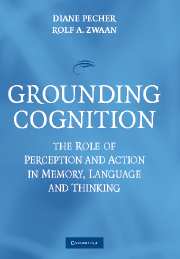Book contents
- Frontmatter
- Contents
- List of Contributors
- 1 Introduction to Grounding Cognition: The Role of Perception and Action in Memory, Language, and Thinking
- 2 Object Concepts and Action
- 3 Constraints on Spatial Language Comprehension: Function and Geometry
- 4 Embodiment in Metaphorical Imagination
- 5 Passionate Thoughts: The Emotional Embodiment of Moral Concepts
- 6 Grounding Language in Bodily States: The Case for Emotion
- 7 Situating Abstract Concepts
- 8 Dynamicity, Fictivity, and Scanning: The Imaginative Basis of Logic and Linguistic Meaning
- 9 The Emergence of Grammar from Perspective
- 10 Embodied Sentence Comprehension
- 11 On the Perceptual-Motor and Image-Schematic Infrastructure of Language
- 12 Connecting Concepts to Each Other and the World
- Author Index
- Subject Index
- References
5 - Passionate Thoughts: The Emotional Embodiment of Moral Concepts
Published online by Cambridge University Press: 22 July 2009
- Frontmatter
- Contents
- List of Contributors
- 1 Introduction to Grounding Cognition: The Role of Perception and Action in Memory, Language, and Thinking
- 2 Object Concepts and Action
- 3 Constraints on Spatial Language Comprehension: Function and Geometry
- 4 Embodiment in Metaphorical Imagination
- 5 Passionate Thoughts: The Emotional Embodiment of Moral Concepts
- 6 Grounding Language in Bodily States: The Case for Emotion
- 7 Situating Abstract Concepts
- 8 Dynamicity, Fictivity, and Scanning: The Imaginative Basis of Logic and Linguistic Meaning
- 9 The Emergence of Grammar from Perspective
- 10 Embodied Sentence Comprehension
- 11 On the Perceptual-Motor and Image-Schematic Infrastructure of Language
- 12 Connecting Concepts to Each Other and the World
- Author Index
- Subject Index
- References
Summary
In the 18th century, David Hume said that every idea is built up from copies of prior impressions. In modern terminology: all concepts are built up from stored records of perceptual states. This empiricist credo is enjoying a resurgence these days. Researchers in numerous fields are seriously investigating the hypothesis that thought has a perceptual basis. They are questioning the rationalist assumptions that have dominated cognitive science since its inception in the 1950s. Empiricism is still a fringe movement, however. It is often dismissed as gratuitously radical and utterly indefensible. That attitude has become something of a dogma, but it derives from two serious worries. One of them has to do with innate ideas. Empiricists have tended to be antinativists, and the current orthodoxy in cognitive science is to postulate a considerable amount of innate knowledge. I think the orthodoxy is mistaken, but I will have little to say about that here. The second major reason for rejecting empiricism has to do with abstract ideas. We often think about things that are far removed from sensory experience. There is no way to paint a mental picture of truth, justice, democracy, or necessity. If empiricism is to have any hope of success, it must be able to explain how we come to think about things at this level of abstraction.
I think the objection from abstract ideas must be dismantled piecemeal. There are different kinds of abstract ideas, and these must be accommodated in different ways.
- Type
- Chapter
- Information
- Grounding CognitionThe Role of Perception and Action in Memory, Language, and Thinking, pp. 93 - 114Publisher: Cambridge University PressPrint publication year: 2005
References
- 17
- Cited by



